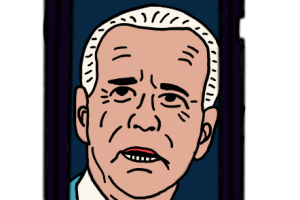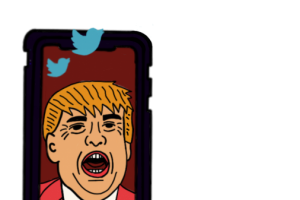Political Issue: Trump: our commander in tweets

It doesn’t matter who you are: If Trump likes what you have to say, he will amplify your message. And he won’t hesitate to use exclamation points.
October 21, 2020
*Opinion
“Covfefe.”
One misspelled word in a 12:06 a.m. tweet sent the Twitter world into a storm in May 2017. Many users tried to figure out what it meant. Some suggested it become the name of a Crayola crayon. Others said it would be the name of One Direction member Louis Tomlinson’s baby, making #covfefe a trending topic.
It seems that no matter what President Trump says to his Twitter audience of 86 million people – gibberish or not – it dominates the headlines for days to come.
Since 2016, President Trump has largely tweeted from his personal account @realDonaldTrump, rather than the official @POTUS account, unlike former President Barack Obama. All tweets from Trump’s personal account are considered official statements. Unlike Trump, Obama would tweet from both the @POTUS account and his personal Twitter, but always signed his name to any @POTUS tweet that was directly from him so as not to mislead the public. Trump, however, has thrown social media precedents out of the Oval Office window.
Known for tweeting at all hours of the night and into the early morning, Trump is constantly sharing campaign videos, retweeting news or making statements. Obama may have been the first president to use Twitter, but Donald Trump, according to The New York Times, has tweeted more than 11,000 times during his presidency. He could easily be called the “Twitter President.” While most media attention is focused on Trump’s Twitter account, he still manages to maintain a large following on other platforms. He reaches an audience of 21.9 million on Instagram and 29.2 million on Facebook, leading Joe Biden (9.5 million Twitter followers) considerably. According to a TKC survey, 15.9% (41/258) of KHS students follow President Trump on at least one social media platform, compared to Biden’s 15.1% (39/258).
Trump is also an avid re-tweeter, sharing tweets from people who agree with him or make a point he likes. He shares tweets from well-known figures like Fox News contributor Lou Dobbs or Grand Old Party (GOP) officials, but also recognizes smaller accounts. It doesn’t matter who you are: If Trump likes what you have to say, he will amplify your message. And he won’t hesitate to use exclamation points.
In his campaign for reelection, Trump has posted about a variety of topics including but not exclusive to campaign messages highlighting his focus on economic well-being and jobs, updates on his rising approval rating, photos from rallies and graphics discussing his recent achievements in peace deals. He caters to what his voters want to hear, and validates their ideas. However, Trump does not run his accounts completely alone. He has Dan Scavino, his communications director since 2018, to thank for parts of his online persona. Scavino first joined the campaign in 2015 to help with Trump’s social media, and is said to be one of Trump’s closest advisers. Scavino has also remained a part of Trump’s team longer than any other individual, excluding family.
This year, Trump expressed disdain when Twitter censored and fact-checked some of his tweets. Two tweets about mail-in voting had a Twitter label (a small, red warning and link at the bottom of a tweet) added to them because Twitter said they “believe those tweets could confuse voters about what they need to do to receive a ballot and participate in the election process.” In late August, Trump retweeted a post containing information about CDC statistics on the coronavirus which were later determined false. Twitter removed the tweet for violating the company’s rules. This began a conversation on Twitter censorship and brought forth accusations of cross-platform silencing of conservative voices.
When it comes to Trump’s social media presence, whether you’re outraged or laughing, offended or entertained, you can’t deny one thing: You’re talking about President Donald Trump.
And that’s exactly what he wants.



